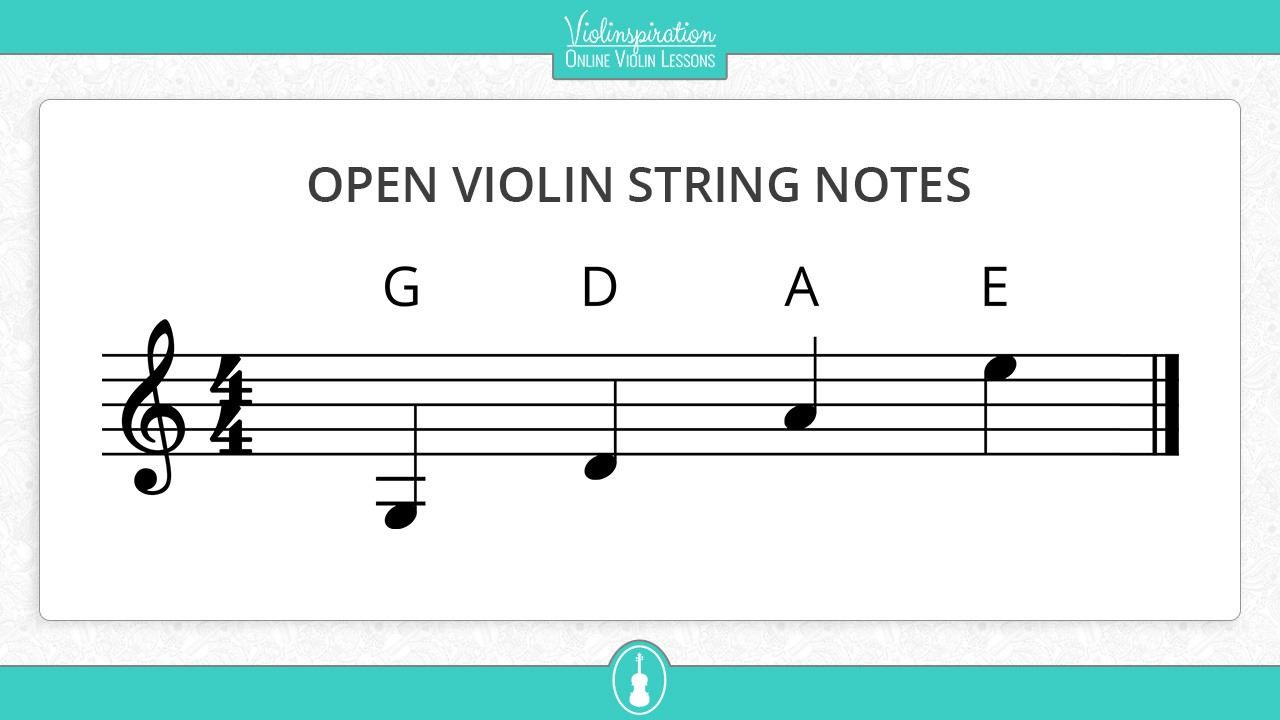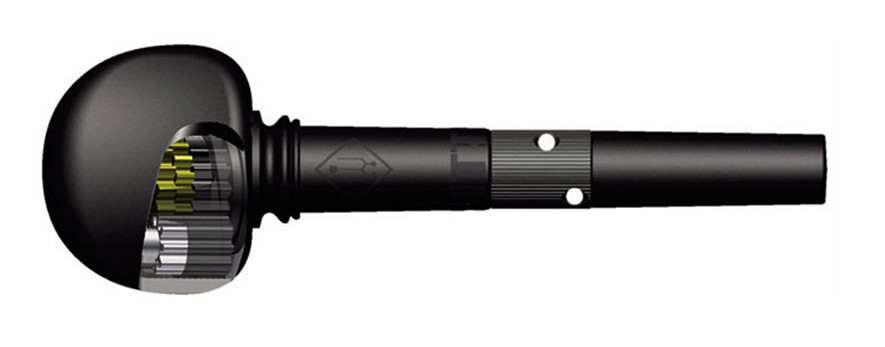Have you ever wondered how to tune the violin with the pegs only? Or maybe you are facing this problem: the string is so out of tune that using fine tuners doesn’t fix the problem – in that case, you have to use the pegs to tune your violin. In this article, I am going to address it all, providing you the simplest solutions possible. Moreover, I am answering the most common questions connected with tuning the violin.
So now, let’s prepare your violin for the practice session!
Before You Start: Violin Tuning Notes
As a quick reminder, the violin strings should be tuned to the following notes:
- E5, the thinnest string
- A4
- D4
- G3
The E string is the highest note; the G string is the lowest note.
Here you can see the violin tuning notes in sheet music:

How to Tune Your Violin with the Pegs
Before you start learning how to tune the violin with the pegs, I want to mention that tuning the violin with the pegs is NOT the easiest way to tune the violin.
A simpler way to tune your violin is by using a combination of pegs and fine tuners.
I described the easiest way to tune the violin in my other guide: how to tune a violin as a beginner.
However, I assume that you are using this lesson because you either don’t have fine tuners or want to learn how to tune the violin with the pegs alone.
Step 1: Switch On or Open Your Tuner
You can either use an electronic tuner or an online violin tuner.
Make sure to switch on the tuner if you use an electronic tuner.
If you use a violin tuning app or online violin tuner, make sure that you allow the app to use the microphone.
You can also use a tuning fork if you would like to tune the violin by ear. I recommend tuning with a tuning fork only to experienced musicians.
Step 2: Place the Violin on Your Knee
Before you begin to tune your violin, place the violin on your knee. In this way, you can easily pluck the strings.
Step 3: Identify to Which String Each Peg Belongs
Next, look at the upper part of your violin. Below the scroll, you can see the pegbox. The pegbox is the part of the violin that holds the tuning pegs. Within it, you can see that each string is coiled around a tuning peg.
When you first start learning to tune the violin with the pegs, it’s important to remember which peg belongs to which string.
As you can see in the image below, on the right side of the violin, you can find the tuning pegs for the A and the E strings. On the left side of your violin, you can find the tuning pegs for the D and the G string.

Step 4: Use the Peg to Tune the A String
Carefully loosen the string by turning the peg a quarter-turn towards yourself (counter-clockwise).
In case the string is totally loose, you can skip this step.
Now slowly turn the peg away from yourself (clockwise) to tighten the string again.
Pluck the string regularly to check if the pitch of your string is already an A.
If the string is still too low, make sure to keep turning it upwards slowly.
If you notice that the pitch of the string is higher than the open A string, you can loosen it again and repeat the process.
In case the string is only a tiny bit higher than the open A string, you can gently pull the string.
If your string has fine tuners, you can also tune the violin with the fine tuner as soon as the pitch is close to the pitch of the open A string. The fine tuners are the small screws on the tailpiece of the violin.
Step 5: Use the Peg to the Other Strings
You can continue this same process with the other strings – turning the pegs to loosen the strings and carefully tightening the strings again by turning the pegs away from you.
I recommend tuning the strings in the following order:
- First, the open A string,
- then the D String
- G String
- and the E string last.
Tune the E string last because it is the thinnest and most delicate string. Because it is so thin, it easily goes out of tune when tuning other strings.
Tuning the Violin with the Pegs by Ear
If you are a more advanced player, you can also tune the strings by ear.
If you are an advanced player, you can start by tuning the A string with a violin tuner or a tuning fork.
After that, you can play the D string and the A string at the same time until you hear that both notes form a perfect fifth. After that, you continue to tune the D and the G string in the same way.
The last step is tuning the A and the E string.
Many advanced players do not have fine tuners on the lower notes of the violin. This is because the fine-tuners ever so slightly impact the sound of the violin. Therefore, the violin will sound a little bit better without the fine tuners. That is why for many professional violinists, tuning the violin with the pegs is the default way of tuning the violin.
Tuning with Wittner Finetune Pegs
Wittner pegs are a special type of violin pegs that have a gearing system within the peg.
In practice, this type of peg works exactly like a fine tuner.
To understand how to tune your violin with Wittner finetune pegs, please check out my guide “How to Tune a Violin as a Beginner,” – in which I explain how to tune the violin with fine tuners. Use the exact same technique described in my guide, but use the Wittner Finetune Pegs instead of the fine tuners.
A common issue with the Wittner Finetune pegs is that if a string is loose or completely out of tune, it can take a long time to tune the string.
In that case, you will have to turn longer than with a usual peg – keep turning the peg quickly until the string is close to the target pitch.

FAQ
Why does my violin keep going out of tune?
There can be two reasons your violin keeps going out of tune: either you have brand new strings on your violin, or your pegs are slipping. New violin strings stretch and go out of tune for about two days until a week before they settle.
If your pegs are slipping, it can have several reasons. The most common reason is that you are not pushing the peg into the peg box while you turn. That causes the peg to not stay in place in the peg box and to slip.
How do you tune a violin without breaking the strings?
To tune the violin without breaking the strings, you must turn the pegs very slowly and carefully. Violin strings usually break because you turned the peg further than the target pitch of the string.
The strings can only hold the tension of the target pitch. If you turn the string higher than the target pitch, you risk breaking the string.
That is why you always loosen the string a quarter-turn before tightening it again to tune the violin.
Can you reuse a broken violin string?
It is not possible to reuse a broken string. As the string usually breaks in the middle, the string is not long enough to put back on the violin again.
If your string breaks, it is usually a sign that it is a very old string (unless you turned the peg too tight). Old strings can sound dull and out of tune when playing your violin, so it is better to change them anyway.
Why do my violin pegs keep slipping?
Violin pegs can slip for four reasons: not pushing the pegs firmly enough into the peg box, improperly installed strings, improperly fitted pegs, and the expansion and contraction of the wood with changing heat and humidity.
How can I keep my peg from slipping?
To keep your pegs from slipping, push the peg into the peg box as you turn when you tune your violin – like putting a cork into a wine bottle.
How do you fix a slipping peg on a violin?
To keep your pegs from slipping, push the peg into the peg box as you turn when you tune your violin – like putting a cork into a wine bottle. Also, make sure that your string is properly attached to your violin.
Here you can see a picture of how it looks when your string is properly attached – the winding of the string is in contact with the side of the pegbox:


Why are my tuning pegs so tight?
Pegs are made from different wood than the main body of the violin. As a result, the pegs expand and contract due to natural heat and humidity changes but in a different way than the other parts of the violin. Also, some pegs are not properly fitted, making them too tight for the holes in the pegbox.
How do you fix tight pegs on a violin?
To fix tight pegs on your violin, gently pull your pegs out of the pegbox when tuning your violin. If you pull the peg out carefully when turning the peg to tune, it will usually loosen. Another way to fix a tight peg is to lubricate your pegs with peg lubricant.
If your pegs are very stuck, it is safest to bring your violin to a luthier to make sure you do not break anything.
How do you lubricate violin pegs?
To lubricate your violin pegs, you first need to buy peg lubricant, sometimes called peg soap, peg wax, peg paste, or peg compound. Next, remove the string attached to the peg from the violin and take the peg out of your violin. Finally, apply the peg lubricant to the peg where it comes into contact with the peg hole.
The peg compound that I am personally using is W. E. Hill & Sons Original Hill Pegsoap.
Final Note
I hope that this easy guide helped you to tune the violin with the pegs!
Please note that tuning with the pegs is NOT the easiest way to tune the violin!
If you are a beginner, an easier way to tune the violin is by using the fine tuners. I explained exactly how to tune your violin with the violin tuners here.
That being said, I hope this article helped you to get good at tuning your violin with the pegs.
Happy practicing!
























